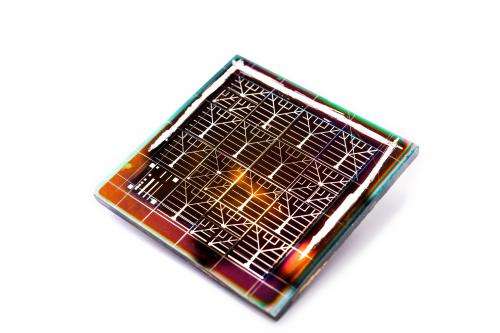Thin-film CZTSe solar cell achieving 9.7% efficiency
At next week's Intersolar conference in San Francisco, imomec, imec's associated lab at the Hasselt University, and Solliance, the European R&D consortium that focuses on thin-film photovoltaic solar energy (PV), will present a CZTSe (Cu2ZnSnSe4)-based solar cell with 9.7 percent efficiency (1x1cm2, AM1.5G). This promising result is an important step bringing the solar industry closer to a sustainable alternative for the highest efficiency thin-film solar cells in production, based on CIGS (Cu(In,Ga)(S,Se)2).
CZTSe is an emerging alternative solar cell absorber in thin-film solar cells, similar to CZTS (Cu2ZnSnS4). Unlike CIGS, CZTS and CZTSe do not suffer from abundancy issues. At 1.5-1.6eV for CZTS, and 0.9eV for CZTSe, their bandgaps make a combined material system ideal for a multi-junction, thin-film solar cell that rivals the efficiency of CIGS cells (about 20 percent). Imomec, imec and Solliance have defined a path towards further improving the layers and cell structures of CZTSe and CZTS absorbers aiming at developing a multi junction CZTS/CZTSe solar cell with 20 percent cell efficiency. The presented CZTSe solar cell is an important step forward to reach this goal.
Imec/imomec fabricated the CZTSe layers by sputtering Cu, Zn and Sn metal layers on a Molybdenum-on-glass substrate and subsequent annealing in an H2Se containing atmosphere, achieving 9.7 percent efficiency. The resulting polycrystalline absorber layers are only 1µm thick, with a typical grain size of about 1µm. The samples were then processed at Helmholtz Zentrum Berlin into solar cells using a standard process flow for thin film solar cells and finished with a metal grid and anti-reflective coating at imec. The highest efficiency obtained on a 1x1cm2 cell was 9.7 percent, with a maximum short circuit current of 38.9mA/cm2, an open circuit voltage of 0.41V and a fill factor of 61 percent.
"This is a big win for us. We've been working toward this milestone since 2011 when we first started our research on alternative materials for thin-film photovoltaics at imec/imomec," said Marc Meuris, program manager Solliance of the alternative thin-film PV program. "Our efficiencies are the highest in Europe and approaching the world record for this type of thin-film solar cells, and we look forward to further advancing R&D to help bringing to market sustainable energy sources."
The sputtering of the Cu, Zn, Sn layers was performed at Flamac (Gent), and the international glass manufacturer AGC delivered Molybdenum-on- glass substrates. Imec's thin-film solar cell activities at imomec (imec's associated laboratory at the university of Hasselt) are integrated in the Solliance cross-border collaboration platform, and the research was partially supported by the Flemish 'Strategisch Initiatief Materialen' (SIM) SoPPoM program.
Provided by IMEC





















